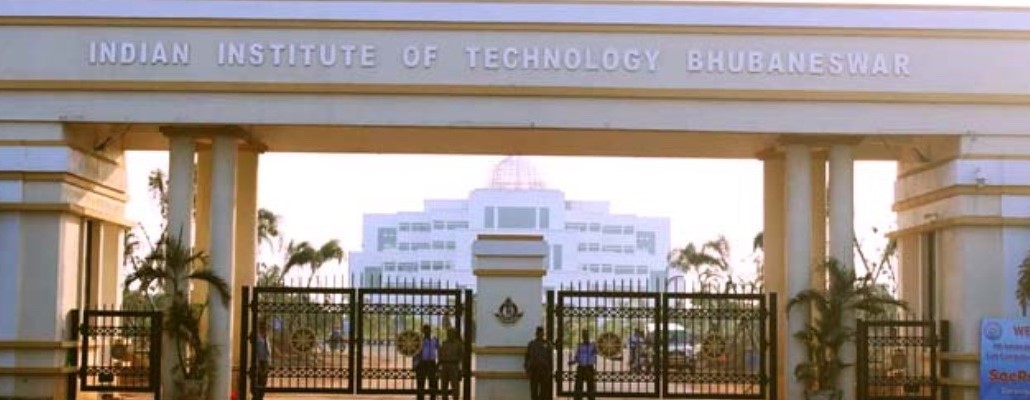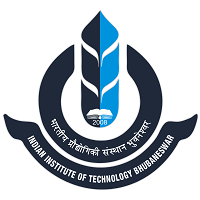
IIT Bhubaneswar
About
Indian Institute of Technology Bhubaneswar (IIT Bhubaneswar) is a public technical university established by the government of India in 2008, located at Bhubaneswar, Odisha, India.
The institute admits
a students for bachelor's, master's programs via JEE Advanced and Graduate Aptitude Test in Engineering respectively. The permanent campus at Argul, Khordha District was inaugurated by the current prime minister
of India, Narendra Modi on 24 December 2018. The area of research are on science, engineering and humanities.
History
The main campus of IIT Bhubaneswar is situated at the foot of Barunei Hill. Famous for its rich history of sustained resistance during 1803 – 1804 against the British occupation of Khurda Garh, the last independent
fort of India, and for the first freedom struggle in India (the Paika Bidroha during 1810 – 1817), Barunei Hill is also a beautiful tourist spot. With Barunei temple, the Swarna Ganga, many spots related to
the stay of Pandavas on the Hills during their agnatabasa, and the all-round greenery, Barunei Hill presents a major site of tourist attraction.
Barunei Hill
Barunei Hill is about 7 km long, 800 m wide, and 304.8 m above the sea level (150 m above the ground level).
Barunei Temple
The principal deities of the temple of Barunei are the twin Goddesses Barunei and Karunei. Clad in battle dresses, they are considered as the manifestations of Shakti and were worshipped
by the kings and paikas of Khurda Garh whenever they proceeded to a war.
One has to climb 88 steps to reach the Temple. The idols are made in black stone (kala mugunipathar) and are each about 18 inch
high. The two deities stand close to each other, with Goddess Barunei on the left and Goddess Karunei on the right.
Swarna Ganga
Swarna Ganga is a perennial stream flowing down the Barunei hilltop. The water of this beautiful stream has many medicinal qualities and it gets stored in a pond where many people take
bath.
Pandava Cave and Other Related
It is believed that Pandavas spent their agnatabasa (Unknown Stay) on the Barunei hills. Pandava cave, Pandava Guha, Pandabahara, and Shree Ram Pathar are reminiscent
of their stay here.
Khurda Fort – Its Rise and Fall
Fall of the Odisha King Mukunda Dev
In 1549, Chakra Pratap Dev became the king of Odisha and made his minister Janardan Bidyadhar as the king of Dakhitaya, the southern territory of his kingdom.
In 1560, however, the commander Mukunda Harichandan became the king, took the name Mukunda Dev and imprisoned the minister Janardan Bidyadhar, who died while he was in prison. Janardan Bidyadhar’s son Ranmachandra
Rautaray Mohapatra (popularly known as Ramei Rautaray) hid in the jungles of Ganjam.
In 1568, the Muslim Ruler Sultan Suleman Karrani of Bengal defeated Mukunda Dev. His commander Kalapahad destroyed
many temples and idols of many deities, and threw the idols of Lord Jagannath, Lord Balabhadra, and Goddess Subhadra of the temple of Puri in the water of river Ganges.
Establishment of Bhoi Dynasty
In 1572, Ramei Rautaray declared himself the king of Odisha with the help of Paikas of Khurda, took the name of Gajapati Ramachandra Dev and made Khurda the capital of his kingdom. Thus started the Bhoi dynasty
of kings in Odisha. Ramei Rautaray was responsible for reinstating the three idols of Lord Jagannath, Lord Balabhadra, and Goddess Subhadra in the temple of Puri. He also started the construction of the Khurda
fort at the foot of Barunei Hill, and made Goddess Barunei and Goddess Karunei Khurda Garh’s presiding deities.
Although parts of Odisha came under the rule of Afgan Sultan (1568 – 1592), Moghul kings
(1592 – 1751), and Marahattas (1751 – 1803), the kings of Bhoi dynasty continued to assume control over Khurda fort and its surrounding areas for 231 years (1572 – 1803). For example, the king Ramachandra Dev
had a friendship treaty with Man Singh, the commander of Akbar, and retained control over 71 gadajatas including Khurda and 29 jamindaris.
Khurda King Birakishor Dev (1760) had taken the help of the
Maratha king, Shivaram Bhatta Shathe, to defeat the Paralakhemindi king Narayan Dev. Birakishor Dev gave Purusuttam Kshetra and four main mahalas (Lambai, Sirai, Rahanga, and Chabiskuda Pragana) to Sathe in
return for the help received.
The Onset of British Rule in Odisha
The British first arrived in Odisha in 1633 after they were permitted by the Moghul king of Delhi to have trade centers at Harishpur, Jagatsinghpur, and Balasore.
In 1803, the British had the full control of the undivided India excepting for Khurda Garh and its surrounding areas held in control by the 12th king Mukunda Dev of Bhoi dynasty. At that time the king had, in
his court, Jayakrushna Mahapatra as Rajguru (popularly known as Jayi Rajaguru), Baxi Jagabandhu Bidyadhar Mahapatra Bhramarabara Ray as chief commander, and Krushnachandra Bhramarabara Ray as his Diwan.
In that year, the British defeated the Marahattas in Barabati fort at Cuttack in a fight that lasted only a few hours. In that fight the British colonel Harcourt had sought and received the help of king Mukunda
Dev to permit his soldiers from Madras Presidency to pass through his state to reach Cuttack. Jayi Rajaguru advised the king not to permit the British soldies to pass through his state. Heeding his advice the
king did not permit the British soldiers to pass through Banpur and Khurda but permitted them to pass through Puri with a hope of getting back the four mahalas that his forefather King Birakishor Dev had conceded
to the Marahattas. However, after the British defeated the Marahattas and took over Cuttack, they not only did not return the mahalas to the king, but asked him to surrender.
Jayi Rajaguru and His
Valiant Attempt to Save Khurda Fort from British Takeover The minor king Mukunda Dev was not ready to fight against the British and retreated to Puri. Jayi Rajaguru, on the other hand, led the fight against
the British. He defeated the British initially, held the Khurda fort for three weeks against the ferocious British army, but could not stand against the much superior opponent. Finally, he lost the war and was
caught by the British as a prisoner and was killed brutally in Medinapur. Thus came the end of the valiant Jayi Rajaguru who gave his life to preserve the freedom of Khurda, and thus came the end of the glory
of Khurda Fort, the last fort of India to be conquered by the British.
Baxi Jagabandhu and the First War of Independence
Baxi Jagabandhu (full name Baxi Jagabandhu Bidyadhara Mahapatra Bhramarabar Ray) was born at Rorar Garh near about 1769 and was the chief commander
of the Army of the minor Khurda king Mukunda Dev. The history is silent on his role during the war against the British that was led by Jayi Rajaguru.
After the British takeover of Khurda, many had
hoped for good administration and respect for the prevailing social order. The British, however, deprived many aristocrat families of their control over their land, replacing them by non-Oriya aristocrats, and
levied new taxes. Baxi Jagabandhu rallied the disgruntled Paikas from around Khurda and the nearby estates, got the support of the trival Khandha community of Ghumusar and led the fight against the British on
1 April 1817 and defeated them on 4 April 1817. Jagabandhu requested the erstwhile king Mukunda Dev (then residing at Puri) to lead the rebellion, but he was not favourable to that idea. This did not stop Jagabandhu
from continuing the rebellion. The rebellion spread like wild fire to places like Puri, Kujanga and Pattamundai where many British soldiers and informers were killed. The British, however, declared marital law
and attacked the rebels on 17th April and defeated them. Jagabandhu along with his friends fled to the jungles of Ganjam and resorted to guerrilla warfare against the British. The Guerilla war continued for
eight years. The British announced that they would award anyone who informs them about the whereabouts of Jagabandhu. They even held the family members of Jagabandhu as prisoners for some time. But these tactics
were of no avail. Finally, the king of Nayagarh mediated between the British and Jagabandhu. The Martial Law was lifted; control of land was restored; and general amnesty was granted to Jagabandhu and his friends.
Ppersuaded by the king, Jagabandhu finally surrendered on May 27, 1825. He remained under house arrest in Baxibazar, a place named after him, in Cuttack up to his death on 24 January 1829. Thus came the end
of the First War of Independence led by Baxi Jagabandhu who remained for ever in the mind of every Odiya as an epitome of bravery and leadership.
Department
Academics
Indian Institute of Technology Bhubaneswar (IITBBS) was established on 22nd July, 2008. The Institute strives to offer the best engineering education with unmatched novelties in curriculum. Within a short
span of incipience, IITBBS has made rapid strides towards becoming one of the elite technology institute of India spurred by sustained creation of knowledge and innovation, through high quality R&D activities
and commitment to holistic education. The Institute aims to develop and pursue dynamic and flexible curricula designed to facilitate creativity and cognitive thinking among students through productive partnership
with industries. Students get exposed to a wide variety of activities through societies and clubs, involving liberal arts, design, dramatics, robotics, music, dance and sports, instilling them with social awareness,
a spirit of innovation, entrepreneurship and a thirst of discovery.
All academic activities of the Institute are being carried out from the picturesque permanent campus at Argul, in the state of Odisha,
India, which has rich historical background. Permanent campus of IITBBS is spreading over 936 acres of land with unique serene and pollution-free academic environment. It is located on the foothills of the magnificent
Barunei, having link with Indian freedom movements.
Campus
The permanent campus of IIT Bhubaneswar is spreading over 936 Acres of land. It is situated at the foot of Barunei Hill, which is famous for its rich history. The campus provides a unique serene and pollution free academic environment. IIT Bhubaneswar has Academic area, Residential area and area for Training centres and Research Park. Although IIT Bhubaneswar had started functioning from two transit campuses in the Bhubaneswar city during its inception period, majority of residential and academic activities have now started in the permanent campus at Argul.
Placement
| Branch |
2017-2018 |
|
CSE |
100% |
|
EE |
83.3% |
|
MMME |
88.88% |
|
ME |
91.42% |
|
Civil |
62% |
|
Overall |
87% |
|
Overall Average Salary |
11.15L |
Placement Detials Click here
FEE Structure
|
Particulars |
Amount |
|
Caution money (One Time, Refundable) |
5000 |
|
One Time Fees |
3900 |
|
Tution Fee (Per Semeste) |
100000 |
|
Other Fees (Per Semester) |
3000 |
|
Annual Fees |
1300 |
|
Total |
113200 |

